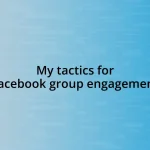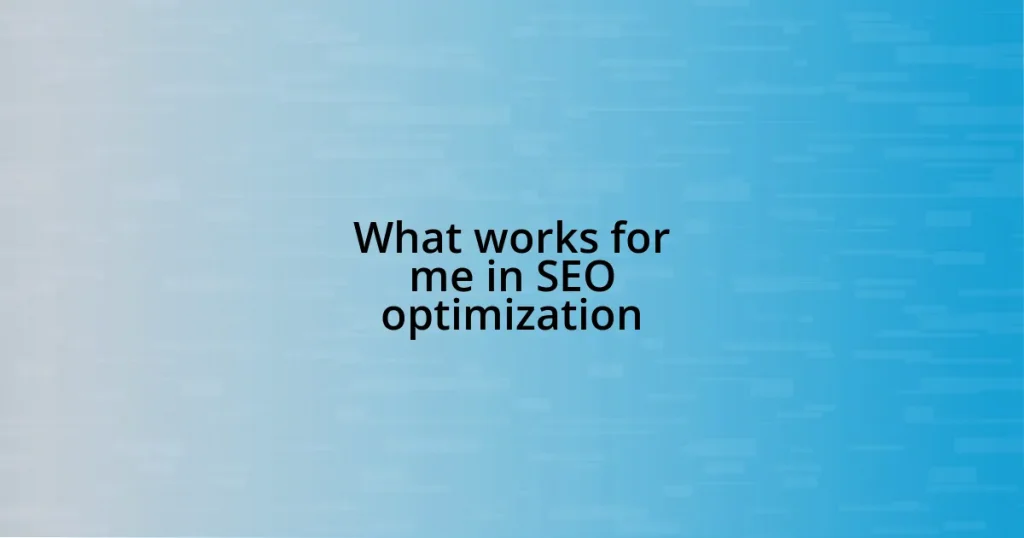Key takeaways:
- Setlists serve as a narrative arc, critical for maintaining audience engagement and emotional flow during live performances.
- Understanding the audience and venue is essential; tailoring the setlist to match crowd energy and space can enhance the performance experience.
- Choosing songs involves balancing personal favorites with audience preferences and ensuring a diverse mix that keeps listeners connected.
- Regularly evaluating and adjusting setlists based on audience reactions and performance outcomes leads to more memorable shows.

Understanding the Importance of Setlists
Setlists are not just a list of songs; they are the backbone of any live performance. I remember my first gig where I naively threw together a few favorites, only to realize mid-set that the energy was all over the place. It struck me then how pivotal a well-thought-out setlist is in maintaining the audience’s engagement and the overall vibe of the show.
When I think about the importance of setlists, I visualize them as a narrative arc. Each song transitions into the next, crafting an emotional journey for the listeners. I often ask myself, “What do I want my audience to feel?” For instance, slowing down after an energetic peak can create an intimate moment, allowing the audience to connect deeply. Isn’t that connection what we strive for?
Moreover, a setlist can influence the performers too. I once had a night where the opening song didn’t resonate, and I felt the energy drop. It reminded me that our choices directly affect not only the audience but our own performance and enthusiasm. So, how do we strike that balance? By thoughtfully curating a setlist that guides both the band and the audience, creating an unforgettable experience.

Assessing Audience and Venue
When planning a setlist, understanding the audience is crucial. I’ve often tuned into the crowd’s energy, watching expressions and movements to gauge their vibe. For example, during an outdoor concert one summer evening, I noticed the audience responding exuberantly to upbeat songs while visibly relaxing during slower numbers. This insight guided my choices, ensuring I matched the setlist to their mood.
The venue also plays a significant role in decision-making. A cozy, intimate bar calls for a different approach than a grand festival stage. I distinctly remember a show in a small venue with just a handful of attentive listeners. I decided to swap out one of my more electrifying tracks for a stripped-down acoustic piece, resulting in a magical connection that wouldn’t have been possible in a larger setting. The space influences not just the songs, but how we interact with the audience.
Assessing both the audience and the venue often leads to a seamless flow in performance. Writing my setlist with these factors in mind has transformed my approach to live shows. At a recent gig, I crafted a setlist that transitioned from lively anthems to heartfelt ballads, and the venue’s acoustics amplified each note beautifully, creating an unforgettable experience. Engaging with these elements adds depth to the performance and keeps the crowd wanting more.
| Factor | Considerations |
|---|---|
| Audience | Energy levels, preferences, and engagement |
| Venue | Size, acoustics, and atmosphere |

Choosing the Right Songs
Choosing songs for a setlist is a delicate process that requires more than just nostalgia for past hits. I once faced the daunting task of selecting tracks for a major festival, balancing what I loved with what my fans craved. It was a tough choice, but I realized that every song needs a purpose—whether it’s to uplift, soothe, or energize. The right mix can make the audience feel seen and connected, transforming a good show into a memorable one.
Here’s how I go about choosing the right songs:
- Mood Impact: Consider how each song will affect the emotional tone of the set.
- Diversity: Ensure a blend of tempos and styles to keep the audience engaged.
- Signature Pieces: Include standout tracks that define your musical identity.
- Audience Favorites: Pay attention to songs your fans love, as they create excitement and familiarity.
- Personal Connection: Reflect on what songs truly resonate with you personally; authenticity shines through.
I’ve also learned the importance of story in song selection. For instance, I had a gig where I transitioned from an upbeat anthem to a poignant ballad. The crowd shifted from dancing to deep introspection, and I could feel the emotional release in the room. It’s those moments that remind me why I love live performance: crafting a journey that both I and my audience can experience together.

Creating Dynamic Flow and Energy
Creating a dynamic flow and energy in a setlist is all about pacing. I’ve often found myself thinking about how one song can lead into another. There was a time when I played a show that started with a high-energy track, then seamlessly transitioned into a rhythmic groove. I saw the crowd’s energy shift as they began to sway, and it felt like riding a wave together. That kind of connection illustrates the power of thoughtful song placement.
It’s also vital to read the room throughout the performance. I remember a particular night when I planned an exciting encore but felt the vibe calling for something softer. Instead of going full blast, I opted for a gentle ballad that resonated deeply. The result? An unforgettable moment where everyone sang along, creating a shared experience that truly encapsulated the spirit of the evening. How often do we overlook that instinct to adjust our plans based on what we feel in the moment?
Ultimately, I’ve learned that allowing moments to breathe in a setlist can elevate the overall experience. I aim to create spaces where the audience can reflect, cheer, and even let loose. The energy shouldn’t just build; it should ebb and flow like a conversation, giving everyone a chance to engage. This back-and-forth dynamic often becomes a powerful bond, making each performance unique and memorable. Don’t you think that’s what truly makes live shows special?

Incorporating Audience Engagement
Audience engagement is essential to creating that electric atmosphere at a live performance. I remember a night when I invited fans on stage to share a particular song’s meaning. The sheer joy on their faces as they shared their stories added an intimacy to the show that simply performing alone couldn’t capture. It reminded me how deeply music can connect us, emphasizing that engagement doesn’t just happen through the music itself, but also through personal interaction.
Thinking about how to incorporate the audience’s energy is equally important. For instance, I once paused mid-performance and turned to the crowd, asking them to sing a familiar chorus back to me. I felt like the whole room transformed into one vibrant voice, and that moment created a bond stronger than any effects or lights could achieve. It wasn’t just about the song anymore; it became a shared experience that left everyone buzzing long after the last note.
Moreover, adapting your setlist based on audience reactions can elevate the performance to new levels. During one show, I noticed the crowd responding enthusiastically to a lesser-known track. I decided to extend that part of the set by improvising and engaging them further, which resulted in an incredible synergy. So often, we focus on our plans, but engaging the audience can open doors to unexpected, unforgettable moments. Isn’t that the magic of live music?

Testing and Adjusting the Setlist
Testing a setlist is a crucial process that can’t be overlooked. I remember my first attempt to blend new material with fan favorites. After a rehearsal, I realized one song, while a personal favorite, just wasn’t clicking. That realization prompted me to swap it for a lively track that not only lifted everyone’s spirits but also had the audience singing along. How often do we find ourselves attached to a song that doesn’t resonate? It’s vital to be flexible and open to change.
During actual performances, I’ve learned the importance of gauging reactions on the fly. I recall a gig where I threw in an unexpected cover midway through the set. The excitement in the crowd surged instantly, which made me want to ride that wave longer. That moment taught me that spontaneity can sometimes reignite the energy in a show, keeping the audience engaged and wanting more. Have you ever felt the difference when a performer takes a risk? It’s that thrill that can transform a good show into an unforgettable one.
After testing different versions of my setlist, I always take the time to reflect on what worked and what didn’t. One night, a slower song felt out of place and broke the momentum, but when I followed it with a fun jam, the energy returned quickly. This ongoing cycle of testing and adjusting not only enhances my performance but deepens my connection with the audience. Isn’t it amazing how every show offers a fresh opportunity to discover what truly resonates?

Evaluating Performance Outcomes
Evaluating performance outcomes is a pivotal step in my setlist planning. After each show, I often sit down with my thoughts and reflect on the vibe of the night. I remember one particularly energetic concert where I felt the crowd was fully with me. When I examined the setlist later, I realized that the songs that truly resonated were the ones that the audience had shouted back at me. It made me think: what can I learn from those moments? Every performance holds lessons waiting to be uncovered.
I’ve also taken to recording performances to analyze them later. There was a time when I thought a certain song was a crowd favorite, but upon watching the footage, I noticed people drifting off. This was a wake-up call! I understood then that what I consider a high-energy piece might not always ignite the same spark in others. Have you ever misjudged a song’s impact? It’s a humbling experience that genuinely drives home the need for honest evaluation.
Engaging with my bandmates after a show provides another layer of insight into performance outcomes. One evening, after a particularly rowdy set, one of my musicians pointed out how one song turned the crowd into a wild sea of movement. Hearing that echoed the joy I felt on stage, and we ended up deciding to keep it in our future sets. It’s fascinating how shared experiences can reveal dynamics we might overlook individually. So, how can we ensure each performance continues to grow? By keeping the dialogue open and attentive to the responses of both the audience and each other.















